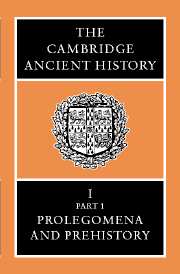Book contents
- Frontmatter
- Contents
- List of Maps
- List of Tables
- List of Text-figures
- Preface
- Chapter I The Geological Ages
- Chapter II Physical Conditions in Eastern Europe, Western Asia and Egypt Before the Period of Agricultural and Urban Settlement
- Chapter III Primitive Man in Egypt, Western Asia and Europe in Palaeolithic Times
- Chapter IV The Evidence of Language
- Chapter V The Earliest Populations of Man in Europe, Western Asia and Northern Africa
- Chapter VI Chronology
- Chapter VII (a) The Earliest Settlements in Western Asia from the Ninth to the End of the Fifth Millennium B.C.
- Chapter VII (b) Anatolia Before 4000 B.C.
- Chapter VIII The Development of Cities From Al-‘Ubaid to the End of Uruk 5
- Chapter IX (a) Predynastic Egypt
- Chapter IX (b) Palestine During the Neolithic and Chalcolithic Periods
- Chapter IX (c) Cyprus in the Neolithic and Chalcolithic Periods
- Chapter X The Stone Age in the Aegean
- Bibliographies
- Index to Maps
- General Index
- Maps
Chapter V - The Earliest Populations of Man in Europe, Western Asia and Northern Africa
Published online by Cambridge University Press: 28 March 2008
- Frontmatter
- Contents
- List of Maps
- List of Tables
- List of Text-figures
- Preface
- Chapter I The Geological Ages
- Chapter II Physical Conditions in Eastern Europe, Western Asia and Egypt Before the Period of Agricultural and Urban Settlement
- Chapter III Primitive Man in Egypt, Western Asia and Europe in Palaeolithic Times
- Chapter IV The Evidence of Language
- Chapter V The Earliest Populations of Man in Europe, Western Asia and Northern Africa
- Chapter VI Chronology
- Chapter VII (a) The Earliest Settlements in Western Asia from the Ninth to the End of the Fifth Millennium B.C.
- Chapter VII (b) Anatolia Before 4000 B.C.
- Chapter VIII The Development of Cities From Al-‘Ubaid to the End of Uruk 5
- Chapter IX (a) Predynastic Egypt
- Chapter IX (b) Palestine During the Neolithic and Chalcolithic Periods
- Chapter IX (c) Cyprus in the Neolithic and Chalcolithic Periods
- Chapter X The Stone Age in the Aegean
- Bibliographies
- Index to Maps
- General Index
- Maps
Summary
I. AUSTRALOPITHECINES AND PITHECANTHROPINES
During the course of human evolution, three major phases of morphological change can be distinguished (Table 4). These divisions belong to the realm of palaeontological convenience and are not an actual fact, for hominid development consisted of the cumulative effect of micro-evolutionary changes giving rise in time and space to a complex mosaic of physical change. These changes were dependent upon such factors as mutation, selective pressures, size of population, and—more important in man than any other creature—upon cultural development such as tool making, language formation, and transmission of complex information.
The earliest group of hominids, described now in some detail, may be considered together under the general title of Australopithecines. 1 They may be briefly characterized by a brain capacity of about 400—800 c.c; dental features showing considerable variability, but generally showing closer affinities with the human dentition than pongid teeth; a foramen magnum placed more forward; a remarkably human pelvis and probably a fairly upright posture. Even allowing for marked sexual dimorphism, it is still obvious that more than one species demands recognition. There is wide agreement that this group represents the beginning of human differentiation from a more basic ‘proto-hominid’ stock. There is still some debate as to what fossils should and should not be regarded as Australopithecines, and clearly palaeontological divisions of this kind must include specimens of a ‘marginal’ or ‘intermediate’ nature.
The Australopithecines were widespread in Africa and if, as some suggest, related forms were present in South-east Asia, they could well have occurred in the eastern Mediterranean area at some time. As yet, the only possible evidence of this are hominid fragments from Tell ‘Ubaidlya in Palestine near the southern shore of Lake Tiberias. Although the tools appear to be of the same crude form as at certain African Australopithecine sites, there is still some doubt as to the contemporaneity of the human skeletal fragments with the deposits, and we must await a more detailed report on this site.
- Type
- Chapter
- Information
- The Cambridge Ancient History , pp. 156 - 172Publisher: Cambridge University PressPrint publication year: 1970



